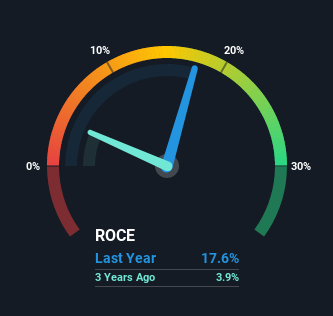- United States
- /
- Marine and Shipping
- /
- NYSE:EGLE
Eagle Bulk Shipping (NASDAQ:EGLE) Might Have The Makings Of A Multi-Bagger

To find a multi-bagger stock, what are the underlying trends we should look for in a business? In a perfect world, we'd like to see a company investing more capital into its business and ideally the returns earned from that capital are also increasing. If you see this, it typically means it's a company with a great business model and plenty of profitable reinvestment opportunities. So on that note, Eagle Bulk Shipping (NASDAQ:EGLE) looks quite promising in regards to its trends of return on capital.
Understanding Return On Capital Employed (ROCE)
Just to clarify if you're unsure, ROCE is a metric for evaluating how much pre-tax income (in percentage terms) a company earns on the capital invested in its business. Analysts use this formula to calculate it for Eagle Bulk Shipping:
Return on Capital Employed = Earnings Before Interest and Tax (EBIT) ÷ (Total Assets - Current Liabilities)
0.18 = US$176m ÷ (US$1.2b - US$166m) (Based on the trailing twelve months to September 2021).
Therefore, Eagle Bulk Shipping has an ROCE of 18%. On its own, that's a standard return, however it's much better than the 10% generated by the Shipping industry.
See our latest analysis for Eagle Bulk Shipping

Above you can see how the current ROCE for Eagle Bulk Shipping compares to its prior returns on capital, but there's only so much you can tell from the past. If you'd like to see what analysts are forecasting going forward, you should check out our free report for Eagle Bulk Shipping.
The Trend Of ROCE
Eagle Bulk Shipping has recently broken into profitability so their prior investments seem to be paying off. About five years ago the company was generating losses but things have turned around because it's now earning 18% on its capital. In addition to that, Eagle Bulk Shipping is employing 26% more capital than previously which is expected of a company that's trying to break into profitability. This can tell us that the company has plenty of reinvestment opportunities that are able to generate higher returns.
For the record though, there was a noticeable increase in the company's current liabilities over the period, so we would attribute some of the ROCE growth to that. Essentially the business now has suppliers or short-term creditors funding about 14% of its operations, which isn't ideal. Keep an eye out for future increases because when the ratio of current liabilities to total assets gets particularly high, this can introduce some new risks for the business.
Our Take On Eagle Bulk Shipping's ROCE
Long story short, we're delighted to see that Eagle Bulk Shipping's reinvestment activities have paid off and the company is now profitable. Investors may not be impressed by the favorable underlying trends yet because over the last five years the stock has only returned 12% to shareholders. So exploring more about this stock could uncover a good opportunity, if the valuation and other metrics stack up.
Eagle Bulk Shipping does have some risks though, and we've spotted 3 warning signs for Eagle Bulk Shipping that you might be interested in.
While Eagle Bulk Shipping may not currently earn the highest returns, we've compiled a list of companies that currently earn more than 25% return on equity. Check out this free list here.
Valuation is complex, but we're here to simplify it.
Discover if Eagle Bulk Shipping might be undervalued or overvalued with our detailed analysis, featuring fair value estimates, potential risks, dividends, insider trades, and its financial condition.
Access Free AnalysisHave feedback on this article? Concerned about the content? Get in touch with us directly. Alternatively, email editorial-team (at) simplywallst.com.
This article by Simply Wall St is general in nature. We provide commentary based on historical data and analyst forecasts only using an unbiased methodology and our articles are not intended to be financial advice. It does not constitute a recommendation to buy or sell any stock, and does not take account of your objectives, or your financial situation. We aim to bring you long-term focused analysis driven by fundamental data. Note that our analysis may not factor in the latest price-sensitive company announcements or qualitative material. Simply Wall St has no position in any stocks mentioned.
About NYSE:EGLE
Eagle Bulk Shipping
Eagle Bulk Shipping Inc. engages in the ocean transportation of dry bulk cargoes worldwide.
Moderate growth potential and slightly overvalued.
Similar Companies
Market Insights
Community Narratives



